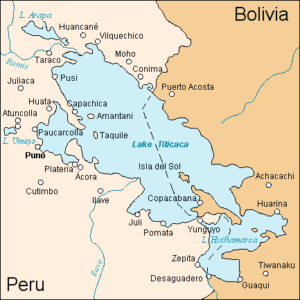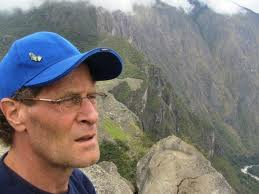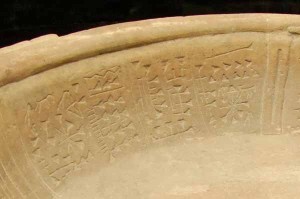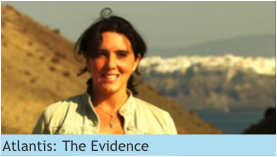Bolivia
Caral
Caral is an important site in the Supe Valley of central Peru near the coast and was part of the Norte Chico civilisation. It was occupied during the third millennium BC, although some push that back as far as the fourth millennium. Caral is claimed to be the oldest urban settlement in the Americas(a), although other sites in the region may challenge that. Arthur D. Faram has written a petroglyphic study of Caral(c).
A 2021 article from the History Channel suggests a date of around 2600 BC for the Caral complex and that it was abandoned about a thousand years later(d).
The 600-hectare site includes a pyramid complex that may have preceded those of the Egyptians. An early quipu was also found at the site suggesting some form of continuity with the later Inca civilisation.
In the 1950s, further south, in the Manchay Valley near the capital Lima, Karola Siebert was convinced that she had found Atlantean remains, while further south again, over the border in Bolivia we have Jim Allen’s chosen location for Atlantis near Lake Poopó.
A French website(b) has on offer the strange idea that the longitude of Caral in Peru and that of Xian in China and their respective relationships with the Prime Meridian at Greenwich and the longitude of Giza have some bearing on the location of Atlantis, which the author, Fabien Pardo, places in the Antarctic!
I reject all South American locations as possibly Atlantean and do so principally because the idea of an attack on Athens being launched from the west coast of South America, thousands of years ago, is, to put it kindly, just silly. However, it is quite clear that this region has had a fascinating prehistory and should keep archaeologists busy for generations to come.
(a) https://www.bibliotecapleyades.net/arqueologia/caral.htm
(b) ATLANTIS AND THE GREENWICH’S MERIDIAN – Site du livre – Pour Eux v1.618 – (archive.org) *
(c) https://migration-diffusion.info/article.php?id=344
(d) This Little-Known Peruvian Civilization Built Pyramids as Old as Ancient Egypt’s – HISTORY
Christopher, Kevin
Kevin Christopher is a confirmed sceptic, whose paper, Atlantis: No way, No How, No Where (a) , is widely available on the internet. It is a lightweight offering, frequently quoting two of the most extreme location theories, such as, Bolivia and Antarctica as justification for his view that the Atlantis story is ‘entirely fictional’.
Christopher also questions the chain of transmission of the story, describing it as ‘tenuous’. But as I have pointed out elsewhere, if Plato had simply concocted the Atlantis tale, it is reasonable to expect that he would also have invented a more straightforward provenance. Consequently, any perceived difficulties in this regard, actually enhance the credibility of the narrative.
>Some years ago Rod Martin wrote a short paper grading the arguments of some of the better known Atlantis sceptics, such as Michael Shermer and Kevin Christopher(b) .<
(a) https://www.csicop.org/sb/show/atlantis_no_way_no_how_no_where
Lake Titicaca
Lake Titicaca is the largest lake in South America and at over three kilometres is arguably the highest navigable lake in the world**, shared by Peru and Bolivia. In spite of claims to the  contrary it is a fresh water lake, but is slowly reducing in size due reduced inflow from the retreating Andean glaciers. Lake Poopó to the south has now dried out completely(a).
contrary it is a fresh water lake, but is slowly reducing in size due reduced inflow from the retreating Andean glaciers. Lake Poopó to the south has now dried out completely(a).
***Karakul in Tajikistan exists at 4,000 metres and “is so salty, it’s almost impossible to navigate a boat on it without capsizing due to the vessel riding so far out of the water.”(e)*
To the south of the lake are remarkable archaeological remains of Tiwanaku and the equally exciting Puma Punku. Both sites have produced some extreme theories regarding the builders of these monuments, their technology level and the date of their construction. Arthur Posnansky, followed by Kurt Bilau have proposed a date of circa 9500 BC as the date of fall of Tiwanaku. There are also reports of pre-Incan structures submerged in Titicaca(d) .
South of Lake Titicaca, near Lake Poopó is Pampa Aullagus, a site identified by Jim Allen as the location of Plato’s Atlantis. While there is little doubt that advanced cultures existed around Titicaca, linking the region to Plato’s story is stretching credibility to its limits. I have already argued in respect of Jim Allen’s Andean theory, that the idea of an invasion of the eastern Mediterranean by an army from the west side of South America is untenable. That they would try it in reed boats like those of Titicaca is equally daft. Then, that this mighty army from ten regions of South America were defeated by the small city-state of Athens is just as laughable.
Equally questionable is the idea that there was a Sumerian presence around Titicaca, in relation to which Clyde Winters quotes(b) James Bailey as well as Ruth and A. Hyatt Verrill in supporting the idea that Lake Manu in Sumerian tradition was in fact Titicaca. The controversial(c) Fuente Magna bowl is also offered as evidence of this idea.
(c) https://www.jasoncolavito.com/blog/the-fuente-magna-bowl-still-fake
*(e) https://www.bbc.com/travel/story/20190207-asias-dead-lake-where-boats-cant-float*
Pampa Aullagas
Pampa Aullagas is the ancient site of Atlantis on the Altiplano of Bolivia according to Jim Allen(a). Compared with the acres of megalithic remains on view at Tiwanaku and Puma Punku(c), the Pampa Aullagas location would appear(b) to offer nothing more than a huge collection of builders’ rubble.
An extensive series of images of the site with interpretations of its features by Allen is available onlined).
(a) https://web.archive.org/web/20200629184756/http://www.atlantisbolivia.org/pampaaullagas.htm
>(b) https://web.archive.org/web/20180726094447/http://www.atlantisbolivia.org/stonesgallery.htm<
(c) https://www.amusingplanet.com/2015/05/the-mystery-of-puma-punkus-precise.html
>(d) https://web.archive.org/web/20200812170147/http://www.atlantisbolivia.org/pampaaullagas3d.htm<
Morrison, Tony
Tony Morrison is probably best known for his definitive work on the Nazca Lines, Pathways to the Gods[1036]. Tony and Marion Morrison have developed the South American Pictures.com website in order to show their extensive life-work. Unfortunately, the southamericanpictures website went offline but now, many of the image collections have been reassembled and are again available online(b).
In 1998 Morrison published a number of papers provocatively entitled The Bolivian Atlantis(b-e). They cover familiar territory – Tiwanaku, Pumapunku, Posnansky, Bellamy, Fawcett, Sykes, Blashford-Snell. This was the same year that Jim Allen published his Atlantis: The Andes Solution[877]. Had Allen not done so, I suspect that Morrison might have produced a more detailed book himself as apparently he and a colleague, Mark Howell, had built up quite a dossier on the subject.
Surprisingly, Morrison did not mention the mysterious puquios of the Nazca region(f), which, with the aid of satellite imagery(g), have been shown to have been part of a sophisticated hydraulic system that supplied water to an extremely arid locality.
*(a) https://nonesuchexpeditions.com/south-american-pictures/sap-archaeology-history-index.htm*
(b) https://www.nonesuchexpeditions.com/South-American-Pictures/sap-archaeology-history-index.htm
(f) https://www.flickriver.com/photos/tags/puquios/interesting/
(g) https://www.bbc.com/future/story/20160408-the-ancient-peruvian-mystery-solved-from-space
Díaz Romero, Belisario
 Belisario Díaz Romero (1870-1940) was a Bolivian businessman and polymath from La Paz. He had some ideas regarding race and evolution(a). that today would be considered odd, if not offensive. He believed that Tiwanaku had been built by a race of people he calls Homo atlanticus, who had come to America from Atlantis, situated in the Atlantic, over a landbridge from the east, over two hundred million years ago! (a)
Belisario Díaz Romero (1870-1940) was a Bolivian businessman and polymath from La Paz. He had some ideas regarding race and evolution(a). that today would be considered odd, if not offensive. He believed that Tiwanaku had been built by a race of people he calls Homo atlanticus, who had come to America from Atlantis, situated in the Atlantic, over a landbridge from the east, over two hundred million years ago! (a)
His 1906 book Tiahuanacu is now freely available online(b).
His ideas regarding Tiwanaku have been linked(a) with those of Edmund Kiss and Arthur Posnansky.
(a) https://theappendix.net/issues/2013/4/andean-atlantis-race-science-and-the-nazi-occult-in-bolivia
(b) https://archive.org/details/tiahuanacuestud00romegoog (Spanish)
Hughes, Bettany (t)
Bettany Hughes (1968- ) is a well-known historian with a high media profile. She has presented one major TV documentary on the subject of Atlantis, specifically supporting aspects of the Minoan Hypothesis. This was Atlantis: The Evidence (Timewatch BBC TWO, 2010)(a) and more recently she has been trotted out to promote a new drama series Atlantis (BBC 2013).
She wrote a preview of this BBC series, for The Telegraph(b), which together with her earlier documentary still raises questions for me about her competence to deal with this subject at all. In her article she refers to the Atlantis story as a moral fable, ignoring the fact that not only were the ‘wicked’ Atlanteans destroyed, but so also were the ‘good’ Athenians.
She then alludes to Plato’s mention of the use of red, black and white stone in Atlantis. It is well known that this combination is common in volcanic regions and has been noted at a number of proposed Atlantis sites; The Canaries, Bolivia, Morocco, Azores, Sardinia and southern Spain.
Next, Hughes tries to explain away the navigation hazard described by Plato, identifying it as pumice. Plato clearly describes mud shoals as the barrier. This would be fine, except that Plato also tells us that the hazard still existed in his day, a thousand years after the eruption. It is improbable, to say the least that pumice would have lingered for a millennium!
These miserable attempts to link Thera and Atlantis are bad enough, Hughes does not explain how Plato repeatedly refers to the Atlantean invasion coming from their base in the the west (Tim.25b & Crit 114c), while Thera/Crete is north of Egypt and south of Athens. Where were the Pillars of Heracles and where were the Minoan elephants?
I would expect a professional like Hughes to offer a more comprehensive review of ALL the information provided by Plato and not dismiss whatever conflicts with her opinion as “sheer fantasy”. This picking and choosing from Plato’s text is not good enough without any justification for her selectivity.
(a) https://www.youtube.com/watch?v=O7bVIq0jNfg
(b) https://www.telegraph.co.uk/culture/tvandradio/10339254/Atlantis-secrets-of-the-real-lost-city.html
Foerster, Brien *
Brien Foerster is an American writer who now lives in Cuzco, the former Inca capital in Peru. He has studied the  ancient cultures of the Andes and believes that many predated the Incas and had advanced technologies that permitted the precise drilling of stone(a). His fully illustrated Kindle book, Lost Ancient Technology of Peru and Bolivia[0923], provides many examples. The book is worth purchasing for the images alone. There is now a video(d) that complements Foerster’s book.
ancient cultures of the Andes and believes that many predated the Incas and had advanced technologies that permitted the precise drilling of stone(a). His fully illustrated Kindle book, Lost Ancient Technology of Peru and Bolivia[0923], provides many examples. The book is worth purchasing for the images alone. There is now a video(d) that complements Foerster’s book.
Foerster has now studied the stonework of the ancient Egyptians and like Chris Dunn concluded that their level of accuracy could not have been achieved without possession of a high technology, now lost(i). He has expanded on this in his 2014 book, Lost Ancient Technology of Egypt[1487].
However, Foerester has recently stepped out of line when he apparently chipped fragments from stones at the Bolivian Puma Punku site with a view to having them tested for age. The laboratory refused to test the fragments as Foerester did not have the appropriate export document from Bolivia(e). It would appear that Foerster is either stupid or criminally irresponsible or both. Apparently, Foerester now claims that the details of this report are inaccurate and may be libellous(f).
This episode is reminiscent of the two German scientists who in 2013 were wrongfully accused of removing part of the ‘Vyse cartouche’ in the Great Pyramid and illegally smuggling it out of Egypt. This was subsequently shown to be a false claim by Zahi Hawass(l).
Elsewhere with regard to Atlantis, he claims “the most plausible idea is that Atlantis was not a single land mass that sank, but was a series of smaller states in the Atlantic area 12,000 years ago.”
In recent interviews, Foerster has proposed that the story of Atlantis is based on an Ice Age civilisation(g). His latest attention-seeking claim is that the Maya visited ancient Egypt, a trip that had some form of Atlantis connection(h).
He has also co-authored with David Hatcher Childress a book on South American cranial deformation and elongated skulls. These are reminiscent of similar skulls found in Malta(c) and Egypt as well as elsewhere around the world and date back many thousands of years(b).
Carl Feagans’ website(j) has a number of articles that are highly critical of Foerster’s methods and motivation. Equally critical is a posting and comments on the newagefraud.org website(k).
(a) https://www.youtube.com/watch?v=xR7of1Lkef0
(b) https://www.atlasobscura.com/articles/head-space-artificial-cranial-deformation
(c) https://nexusilluminati.blogspot.ie/2013/03/ancient-elongated-skulls-and-cranial.html
(d) https://www.youtube.com/watch?v=HmK7Ng0eGV8
(h) https://verumetinventa.wordpress.com/2016/06/28/brien-foerster-good-evidence-of-maya-culture-in-egyptian-pyramids/ (offline October 2017)
(k) http://www.newagefraud.org/smf/index.php?topic=5345.0 *
(l) URGENT URGENT! BREAKING NEWS: EGYPT – Atlantisforschung.de (atlantisforschung-de.translate.goog)
Anstee, Margaret Joan
Margaret Joan Anstee (1926- ) was a distinguished British diplomat who served at  the United Nations for over forty years. She was the UN Deputy Resident Representative for a number of years.
the United Nations for over forty years. She was the UN Deputy Resident Representative for a number of years.
James Bailey referred to her 1970 offering, Gate of the Sun: A prospect of Bolivia[1420], in which she claimed that the Andes got their name from the word ‘antis’ meaning copper. Bailey claimed that Anstee believed America to be Atlantis!
Fuente Magna Bowl
 The Fuente Magna Bowl is a remarkable artefact sometimes called ‘the Rosetta Stone of the Americas.’ It was discovered accidentally near Lake Titicaca in Bolivia. The bowl’s claim to fame is that it has been inscribed with cuneiform writing, similar to Sumerian.
The Fuente Magna Bowl is a remarkable artefact sometimes called ‘the Rosetta Stone of the Americas.’ It was discovered accidentally near Lake Titicaca in Bolivia. The bowl’s claim to fame is that it has been inscribed with cuneiform writing, similar to Sumerian.
It is claimed that thermoluminescence dating has shown the object to be quite ancient and not a forgery. The same site(a) quotes at length a translation of the text by Clyde Winters, but a German website(b) denounces his translation as nonsense, although it accepts that the Bowl as genuine. Another site(c) offers a selection of detailed images of the Bowl.
Carl Feagans’ website(f) is equally critical of Winters’ ‘translation’ and raises a number of questions regarding the authenticity of the artefact.
April Holloway offered an overview of the controversy relating to the Fuente Magna Bowl on the Ancient Origins website, concluding quite reasonably, that further objective linguistic research could bring the debate to a conclusion(g).
Jim Allen and his supporters have sought to link the Bowl with the theory of Atlantis in the Andes(d).
The bad archaeology website has a reasonably balanced article(e) on the bowl which should be read.
>Michel Leygues has published(h) his study of the Fuente Magna Bowl in which he endeavours to demonstrate the relationship between Sumerian, Akkadian, Aymara and Quechua. Unfortunately, so far it is only available in French.<
(a) https://web.archive.org/web/20110727221012/http://www.world-mysteries.com/sar_8.htm
(c) See: https://web.archive.org/web/20160613101558/https://www.faculty.ucr.edu/~legneref/biados/fuentmag.htm
(e) https://badarchaeology.wordpress.com/tag/fuente-magna-bowl/
(f) https://ahotcupofjoe.net/2017/11/fuente-magna-bowl-not-cuneiform-not-sumerian/


